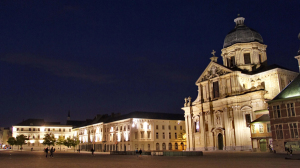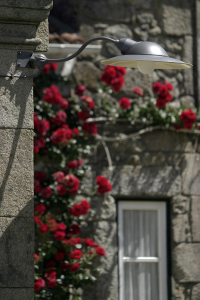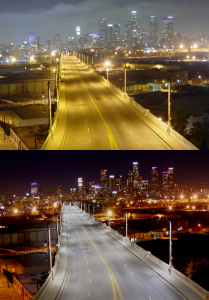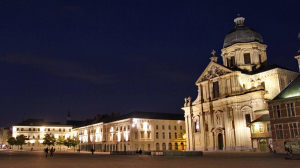The winners of the 2012 edition of the Auroralia award were announced in Lyon on the evening of 7th December during the Lyon Light Festival 2012.
1st Prize – Ghent (Belgium)
With more than 250,000 inhabitants, Ghent is the second most populated municipality in Belgium and the country’s main student city. Wishing to be part of a sustainable development process, Ghent played a leading role on a national level in 1998 by launching a lighting plan. In 2005, the “Rational Use of Energy” project was launched.

Through a continuous and reasonable investment, the Flemish city has gradually modernised its infrastructures to constantly reduce its energy needs. At the same time, it has ensured that its lighting installations are supplied with greener energy.Since 2008, the electricity used by the city is from 100% renewable sources.
Wishing to continue to provide quality lighting, the city has increased the number of lighting points by 10% and continues to scrupulously meet international lighting standards. The new lighting installation generates energy savings of 20% and lowers annual CO2 emission by 1,113 tonnes, i.e. the equivalent of the emissions of 1,000 homes. In the long term, when the dimming system is fully operational, Ghent will reduce its energy needs by a further 20%.
The Schréder Luci Auroralia Award judges were impressed by the perseverance of the city’s commitment. Thanks to its rational approach aimed at a targeted and gradual replacement of its lighting installations, it has reconciled strict financial management with high targets in reducing energy consumption and C02 emissions.

2nd Prize – Valença (Portugal)
Located in northern Portugal, Valença is one of the country’s most charming towns. Throughout history, Valença has played a major defensive role by protecting the province of Minho from invasions. Today, it is a pleasant medieval town whose tourism and commercial activity benefits directly from its proximity to the Spanish border.
In 2006, the municipality launched a project aimed at renovating the public spaces within the town. A significant portion of the project consisted of completely renewing the lighting installations, the inefficiency of which impaired the town’s nocturnal ambiance. The old lanterns were replaced with Coroada luminaires, designed for the occasion by the architect Eduardo Souto de Moura, winner of the prestigious Pritzker Prize.
Initially, the Coroada luminaires were fitted with metal halide lamps before integrating the very latest LED technology.
The Coroada, which perfectly blends into the urban landscape, combines a traditionally inspired aesthetic design with modern technology to provide Valença with a lighting installation that is in line with the architectural heritage while generating substantial energy savings. The Portuguese town has reduced its energy consumption by 69% and its CO2 emissions by over 28.5 tonnes per year.
This urban renewal project which has transformed the nocturnal life within the town was unanimously hailed by the press. The Auroralia judges joined in this overwhelming support by awarding the second prize to this Portuguese town.
3rd Prize – Los Angeles (United States of America)
With over 210,000 lighting points, Los Angeles possesses the second largest lighting system in the United States. In February 2009, the former President of the United States Bill Clinton, at the head of the Clinton Climate Initiative, and the Mayor of Los Angeles, Antonio Villaraigosa, launched a major plan for the conversion of 140,000 luminaires to LED technology.
The first phase of the “Los Angeles LED Conversion Project” focused on modernising the lighting of the residential areas and secondary roads with new luminaires fitted with 20 or 40 LEDs. The second phase of the place took place in the second half of 2012. It involved replacing the luminaires installed on the main roads with units fitted with 60 to 160 LEDs.

Today, with over 100,000 LED luminaires (another 38,000 will be installed in 2013) each generating 50% energy savings compared to the luminaire they have replaced, Los Angeles is reducing its CO2 emissions by no less than 29,500 tonnes per year! In California, 52% of the electricity consumed still comes from plants using fossil fuels (coal). The shift to LED lighting therefore has a very favourable impact on the carbon footprint.
By awarding the third prize to Los Angeles, the Auroralia jury was keen to highlight the driving role played by the Californian megalopolis in the search for greater energy efficiency in the United States.

Special Mention – Buin (Chile)
The city of Buin, on the outskirts of Santiago de Chile, is a popular tourist destination. Its annual wine festival is very popular in the region. Poor lighting had been hampering the festivities due to increasing crime worsening and a growing feeling of insecurity amongst the population.
In 2011, the local authorities decided to tackle the problem by launching a lighting plan based on LED technology to improve the lighting levels and the quality of light while reducing energy consumption and CO2 emissions. They also wished to create a pleasant and harmonious atmosphere so that the inhabitants and visitors would enjoy the public space once more.
The first phase has already borne fruit with the new LED lighting installation of the city’s main square, the Plaza de Armas. Thanks to the replacement of the luminaires, energy consumption and CO2 emissions have fallen by 80%. The precise light distribution of the new LED luminaires also contributes to the preservation of the biodiversity of this green setting.
By awarding a special mention to the Chilean city, the Schréder Luci Auroralia Award jury wished to reward the proactive approach of the Buin authorities.
The Auroralia award, organised jointly by LUCI and Schréder, rewards the best sustainable urban lighting initiatives. A jury panel composed of representatives from the press specializing in urban planning, environment and lighting design judged this year’s 19 entries based on criteria such as the efforts made to minimise the environmental impact of the lighting project (quantified in particular by a reduction in CO2 emissions), the project’s exemplary character, its integration within a larger plan, its socio-economic relevance, its educational dimension and its originality.

